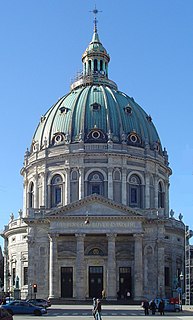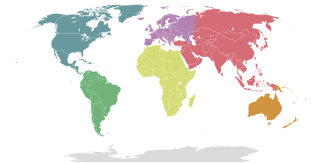
Christian IV was king of Denmark and Norway and duke of Holstein and Schleswig from 1588 to 1648. His 59-year reign is the longest of Danish monarchs, and of Scandinavian monarchies.

The Evangelical Lutheran Church in Denmark or National Church, sometimes called Church of Denmark, is the established, state-supported church in Denmark. The reigning monarch is the supreme secular authority in the church. As of 1 January 2019, 74.7% of the population of Denmark are members, though membership is voluntary.

Nikolaj Frederik Severin Grundtvig, most often referred to as N. F. S. Grundtvig, was a Danish pastor, author, poet, philosopher, historian, teacher and politician. He was one of the most influential people in Danish history, as his philosophy gave rise to a new form of nationalism in the last half of the 19th century. It was steeped in the national literature and supported by deep spirituality.
The United Evangelical Lutheran Church was one of the many denominations formed when Lutherans came to the United States from Europe. Originally known as the United Danish Evangelical Lutheran Church, the United Church merged with other Lutheran groups to form the American Lutheran Church in 1960, which endured until 1988.
Jan Mendoses was a European pirate or merchant who lived during the 17th century. It is possible that Jan Mendoses' real name was Juan [de] Mendoza. There is considerable doubt about his nationality, some sources claiming he was a Belgian named Mandaus, others that he was Spanish. He may even have been a merchant heading for Russia, rather than the "notorious pirate" claimed by Danish sources.

Jens Schou Fabricius was the Norwegian appointed Minister of the Navy 1817–1818. He served as a representative for Søe-Deffensionen at the Norwegian Constitutional Assembly at Eidsvoll in 1814. During his naval career he served first the Danish Crown until the separation in 1814 of Norway from Denmark, and thereafter the Norwegian-Swedish Crown. Fabricius retired from the navy as a vice admiral.

Danish Americans are Americans who have ancestral roots originated fully or partially from Denmark. There are approximately 1,300,000 Americans of Danish origin or descent.

Jens Munk was a Dano-Norwegian navigator and explorer. He entered into the service of King Christian IV of Denmark and is most noted for his attempts to find the Northwest Passage to India.
Thorkild Hansen was a Danish novelist most noted for his historical fiction. He is commonly associated with his trilogy about the Danish slave trade including Slavernes øer (1970) for which he received the Nordic Council Literature Prize in 1971.

Claus Lauritz Clausen was an American pioneer Lutheran minister, church leader, military chaplain and politician.

John Nathan Kildahl was an American Lutheran church minister, author and educator.

Kristian Anker was a Lutheran minister who served as the first president of the combined Trinity Seminary and Dana College.

Jens Arnold Diderich Jensen was a Danish naval officer and Arctic explorer.

Christian IV's expeditions were sent by King Christian IV of Denmark to Greenland and Arctic waterways during the years 1605–1607. The expeditions were commissioned in order to locate the lost Eastern Norse Settlement and reassert sovereignty over Greenland.

Christianity is a prevalent religion in Denmark; 25% of Danes believe Jesus is the son of God, and 18% believe he is the saviour of the world. Aside from Lutheranism, there is a small Catholic minority, as well as small Protestant denominations such as the Baptist Union of Denmark and the Reformed Synod of Denmark.
Events from the year 1619 in Denmark.

Sømandshjemmet Bethel, now known as Hotel Bethel, is a sailor's hostel overlooking the Nyhavn canal in central Copenhagen, Denmark. Today it is mainly used as a residential hotel. The site also comprises a sailor's church.

Rasmus Nyerup (1759–1829) was a Danish literary historian, philologist, folklorist and librarian. He was assistant at the Royal Library from 1778, and its secretary during 1709–1803. From 1803, he was head librarian of Copenhagen University Library. He was a very productive and diligent reviewer and writer, mostly on Danish literary history. With Rasmus Rask, he published a Danish translation of the Edda in 1808, and with Jens Edvard Kraft a general literary history of Denmark, Norway and Iceland (1818/9). He was co-founder of the "Society for Future Generations" and the Scandinavian Literary Society (1796). He initiated the foundation of the National Museum of Denmark.

Bertel Christian Budtz Müller was a pioneering Danish photographer. He operated the photographic studio Budtz Müller & Co. at Bredgade 21 in Copenhagen and was appointed as court photographer in Denmark, Norway and Sweden.













